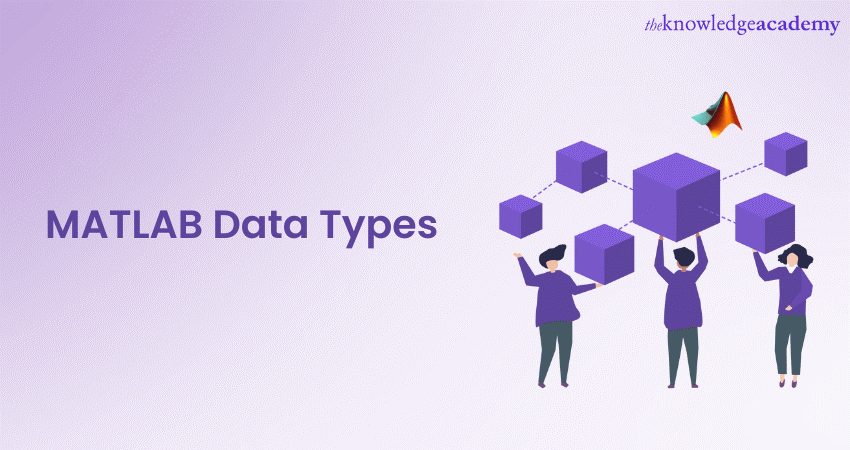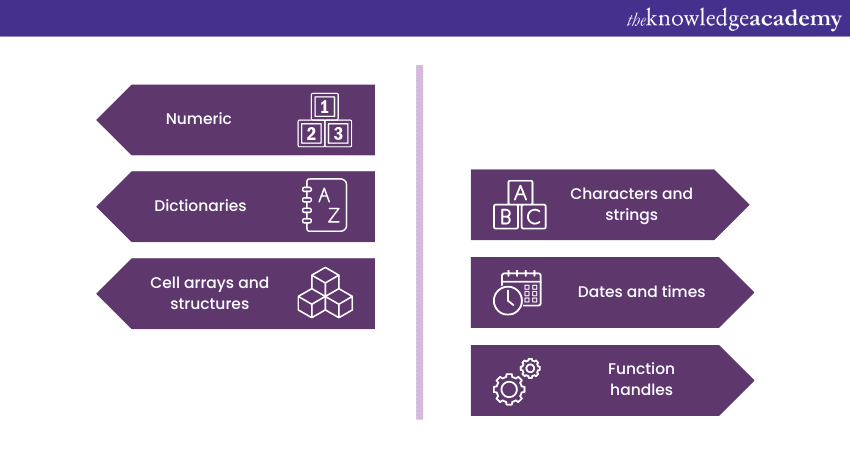We may not have the course you’re looking for. If you enquire or give us a call on +44 1344 203999 and speak to our training experts, we may still be able to help with your training requirements.
We ensure quality, budget-alignment, and timely delivery by our expert instructors.

MATLAB is a robust programming language that offers developers and researchers a wide range of data types to handle various forms of data effectively across engineering and scientific applications. These data types enable precise numerical computations with varying precision and memory usage. In order to effectively use this language, understanding the MATLAB Data Types is essential.
MathWorks, the organisation behind MATLAB's creation, is a leading name in Data Science and Machine Learning, according to Gartner's Magic Quadrant of 2021. An understanding of these data types is essential for MATLAB users to take full advantage of its execution capabilities. Read this blog to learn the various MATLAB Data Types with examples and how to identify them.
Table of Contents
1) Overview of MATLAB Data Types
a) Data Types in MATLAB
2) Identification of MATLAB Data Types
3) Conclusion
Overview of MATLAB Data Types
In MATLAB, data types are essential for effective representation and manipulation. Matlab arrays and matrices are the fundamental data types in Matlab. of various kinds of data. Understanding these data types is essential for effective programming and ensuring accurate results. Let's look at the various MATLAB Data Types:

Data Types in MATLAB

The following are the main MATLAB Data Types:
1) Numeric: MATLAB provides double and single-precision floating-point types, allowing for a wide range of numerical computations with varying precision and memory usage levels. Integers are represented by int8, int16, int32, and int64 for signed values, and uint8, uint16, uint32, and uint64 for unsigned values. If you're interested in signal processing, MATLAB also offers powerful tools for operations like Matlab Convolation within these numerical types. If you're interested in signal processing, MATLAB also offers powerful tools for operations like Matlab Convolation within these numerical types.
Syntax: str = ‘The Knowledge Academy’;
int8(str)
The primary data types under the numeric category are:
a) double: The default data type in MATLAB, which represents double-precision floating-point numbers.
b) single: A data type in MATLAB that represents single-precision floating-point numbers.
c) int8, int16, int32, int64: A MATLAB data type representing signed integers of various sizes like 8, 16, 32 and 64-bit.
d) uint8, uint16, uint32, uint64: This data type in MATLAB represents unsigned integers of different sizes.
2) Dictionaries: Users can implement dictionaries in MATLAB using containers. Map contains the keys from 'keySet', each of which is mapped to a corresponding value from 'valueSet'.
Furthermore, Dictionaries are a convenient way to store and retrieve key-value pairs, allowing for fast lookup operations. Developers can benefit from the flexibility and values of various data types.
Syntax: d = dictionary(keys,values)
3) Cell arrays and structures: These composite data types allow storing heterogeneous data in a single variable. Cell arrays enable flexible storage of different data types, while structures provide named fields to group related data.
Additionally, in MATLAB, cell arrays and structures, augmented with the capabilities of MATLAB operators, are powerful data types for handling heterogeneous data. More importantly, cell arrays can store different data types, while structures group related data using named fields, providing flexibility and organization in data management and manipulation.
Syntax of cell arrays: c = {42, rand(5), “abcd”}
Syntax of structures:
s.a = 1;
s.b = {‘I’, ‘J’, ‘K’}
s = struct with fields;
a: 1
b: {‘A’ ‘B’ ‘C’}
4) Character and Strings: The Character and String are types of data in MATLAB that provide storage for textual data. The character data type represents individual characters, while strings are sequences of characters. For a deeper understanding of how these data types may be tested, check out our MATLAB Interview Questions for common queries related to them. Both data types are described in more detail as follows:
a) Character: Individual characters can be represented using the 'char' data type. You can assign a single character to a variable using single quotes (' '). Characters can be manipulated using operations such as concatenation, indexing, and comparison.
b) String: MATLAB introduced a dedicated string data type starting from R2016b. Strings are represented using double quotes (" ") or the 'string' function. They offer more advanced functionality than character arrays, including methods for string manipulation, concatenation, searching, and formatting.
Syntax example:
C = ‘MATLAB Data Types’
5) Dates and Time: The Dates and Time data type helps developers handle and perform operations on date and time values. MATLAB commands provides a collection of variables for developers to identify and understand the data types of values
Furthermore, the datetime data type enables easy manipulation and analysis of temporal data, offering functions to create, access, and modify date and time values. You can select from various formats and arithmetic operations on dates and times.
Syntax example:
t = datetime (returns an array in a scalar format which corresponds to the current date and time)
6) Function handles: MATLAB provides users with function handles to pass functions to other functions. These functions can be either the numerical or char format. Function handles can be variables used to invoke the function indirectly.
Syntax example: The ‘@’ operator creates a function handle.
Use case: Create a function handle for x^2 + y^2
Output: @(x,y)(x.^2+y.^2)
Learn the MATLAB programming language and navigate the interface, by signing up for the MATLAB Masterclass Course now!
Identification of MATLAB Data Types
features of MATLAB provides a collection of variables for developers to identify and understand the data types of values and variables to ensure correct and efficient programming. Additionally, MATLAB offers several built-in functions for data type identification and conversion.
The "class" function is commonly used to determine the data type of a variable. It returns a string representing the class of the variable, such as "double", "char", "logical", or "cell". This information helps in verifying the expected data type and performing appropriate operations.
The "isa" function checks whether a variable belongs to a specific data type. It returns a logical value, true or false, indicating if the variable is of the specified class. Furthermore, Advantages of MATLAB offers functions like "isnumeric", "ischar", and "iscel" to check for specific data types, such as numeric, character, or cell arrays. When working with complex data structures like structures or cell arrays, developers must verify individual elements' data types.
Join our SPSS Masterclass Course to learn how to use SPSS and perform different statistical functions and calculations.
Conclusion
We hope you enjoyed reading this blog on the different MATLAB Data Types with their examples and how you can identify them. Understanding them is essential for developers and engineers to manipulate data and ensure efficient programming. The mathematical analysis tool allows programmers to optimise memory usage, improve performance, and ensure accurate data representation. Mastering data types lets users write more efficient and powerful code, facilitating optimum utilisation of the language's capabilities.
Perform data analysis and manipulation using MATLAB, by signing up for the MATLAB &SPSS Training Courses now!
Upcoming Office Applications Resources Batches & Dates
Date
 MATLAB Course
MATLAB Course
Fri 6th Jun 2025
Fri 29th Aug 2025
Fri 24th Oct 2025
Fri 26th Dec 2025






 Top Rated Course
Top Rated Course


 If you wish to make any changes to your course, please
If you wish to make any changes to your course, please


